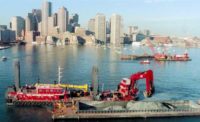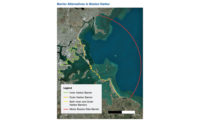If you were hoping for a silver-bullet, big-infrastructure solution to save Greater Boston from the impact of rising sea levels, a major study coordinated by University of Massachusetts Boston’s Sustainable Solutions Lab released in the spring may have come as disappointing news.

A giant barrier walling off the inner harbor to protect the city against rising seas, the report concluded, could cost as much as $85 billion, take 40 years to permit and build, and be nearly impossible to operate reliably given how long it would take to open and close its massive gates during daily tide cycles.
For taxpayers, Greater Boston residents and climate resiliency, however, this report represents a huge win. We learned an enormous amount about what will and what won’t work for augmenting Boston’s climate resiliency, and we are now free to direct our tax dollars on shore and save the region billions of dollars in building more resilient infrastructure.
Led by professor Paul Kirshen, UMass Boston’s Sustainable Solutions Lab academic director, the study team examined the various harbor flood-barrier alternatives. The team concluded that even a more modest scaled flood barrier configuration between Logan Airport and the booming Seaport District of South Boston—with an estimated federal, state and local taxpayer price tag for design, permitting and construction of $8 billion to $12 billion—was a loser in terms of cost-benefit.
With its highest likely cost at $85 billion, a Boston Harbor barrier would have been the largest and most expensive in the world to own and operate. A barrier would still not prevent the future flood losses on shore from heavy rain events or coastal storms that exceed the barrier’s design criteria. The federal government’s return-on-investment methods showed the project would be a blowout loss for taxpayers.
“We are now free to direct our tax dollars on shore and save the region billions of dollars in building more resilient infrastructure.”
After all the questions and alarms raised by hurricanes and storms such as Katrina, Irene, Harvey, Irma, Maria, and Superstorm Sandy, the UMass Boston report provides long-needed clarity that the path ahead for Boston must be win-win, shore-based climate adaptation solutions, neighborhood-scale flood protection, accommodation of water—and even some wise retreats as we relocate people, businesses and industry from areas that can’t be protected from rising seas and storm surges in a cost-effective manner.
Preparing people, the built environment and nature for their vulnerability and their need for resilience to extreme heat waves, heavy precipitation, drought, wildfires and flood impacts due to climate change will be a multigenerational challenge.
There are several takeaways from the UMass Boston report. The first is that taxpayers who live on the shore or visit the Boston Harbor area benefit from a clean, navigable and economically vibrant harbor and shoreline. It is a natural resource we have invested billions into for clean up over the past 30 years and is worth protecting.
The next thing to know is that shore-based solutions to coastal, riverine and precipitation-based flooding can be engineered, permitted and built easier and faster than a big harbor barrier and adapted more quickly and nimbly in design as conditions evolve and as climate modeling is refined.
The report also shows that shore- and nature-based solutions like new open spaces, vegetative berms and living shorelines can accommodate water and storm surges. They also can serve as shaded parks and playgrounds in dry weather and create recreational, social and health benefits.
Taxpayers will need to be prepared for investing in more affordable yet substantial capital expenses of shore-based flood control solutions, which, when properly planned for and designed, provide multiple layers of flood protection. And implementing climate-resilient flood protection long before a natural disaster hits will reduce loss of property, money and lives.
Thanks to the proactive research by Kirshen and his UMass Boston Sustainable Solutions Lab team and the project’s supporters and partners, big infrastructure is off the table as a quick fix for resiliency. This is a clear case of where bigger is not better for taxpayers.
Wayne Cobleigh is vice president for client services at GZA in Norwood, Mass. He was a reviewer for Boston’s harbor-wide barrier preliminary analysis feasibility study. He can be reached at Wayne.Cobleigh@gza.com
If you have an idea for a column, please contact Viewpoint Editor Richard Korman at kormanr@enr.com.





Post a comment to this article
Report Abusive Comment